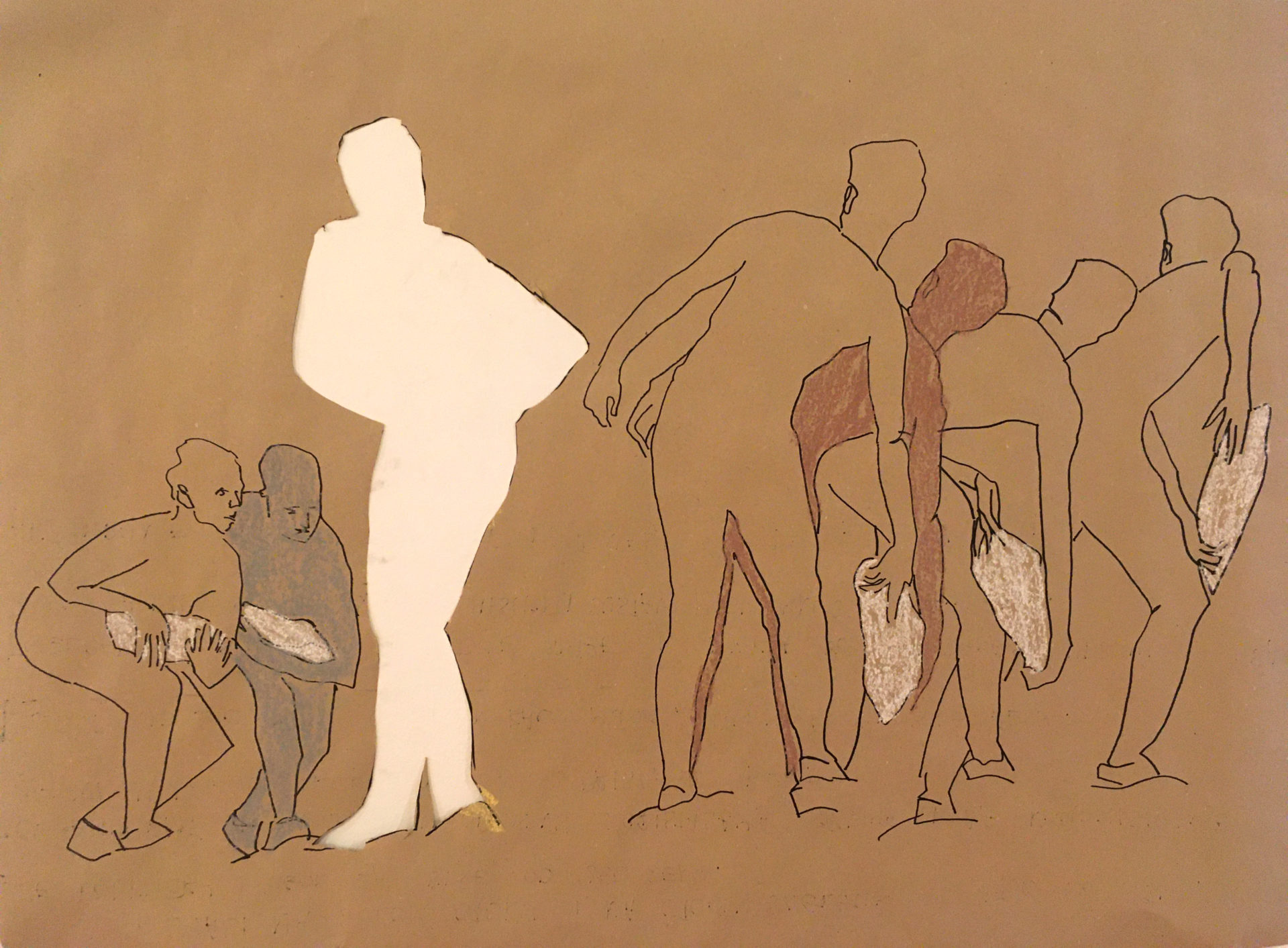
Goli Otok, “Barren Island,” is most renowned as a camp for male political prisoners in former Yugoslavia, but little is known about the island’s history as a prison camp for women.
To learn more about this lesser known part of the camp’s history and the transgenerational transmission of trauma, anthropologist Renata Jambrešić-Kirin, together with artist Andreja Kulunčić and psychotherapist Dubravka Stijačić, launched the project “You Betrayed the Party Just When You Should Have Helped It,” The project is named after the words with which Marija Zelić, the first warden of the women’s camp, welcomed its prisoners.
“Years of collaboration with the artist Andreja Kulunčić and the psychotherapist Dubravka Stijačić taught me that with the help of the tools of contemporary art, society can be sensitized to historical problems in a contemporary context and made aware of the fact that we are constantly on the verge of repeating violent history,” said Jambrešić-Kirin.
As she explained, the project focuses on the problem of state violence as an important factor in the (dis)continuity of women’s history, understood as the history of constantly starting and thwarting the fight for women’s rights.
Analyzing the oral and written testimonies of former political prisoners, Jambrešić-Kirin found that the Yugoslav state security archives provide an incomplete picture of the period in which ideological control and surveillance of citizens were ubiquitous.
“The personal files in the State Security Administration’s collection – which were scattered between state and republic institutions – were censored, removed, and destroyed. Precisely because of the nature of secret service activities, including blackmail and the manipulation of both people and bureaucratic shortcomings, official data is not completely accurate, reliable, or comprehensive,” Kirin-Jambrešić explained.
After counting the women’s names listed in the logs of Goli Otok and St. Gregory prisons as well as those recorded in written memoirs, Jambrešić-Kirin concluded that the number of women arrested was greater than 862.
Penitentiary for Women’s Cultural Re-Education
Goli Otok functioned on a unique system of prison self-governance where female prisoners investigated, policed, snitched, punished, and humiliated each other with special degradation “ceremonies.” Research also shows that female partisans, pre-war communists, and Jewish women who survived the Nazi camps were the most dominant of the female prisoners.
“On the one hand, it has to do with the Bolshevik mentality that suspects the ‘moral corruption’ of all those who survived the Nazi camps, and on the other hand, it has to do with a fear of powerful women, intellectuals, and political competitors,” Jambrešić-Kirin points out.
Prisoners on Goli Otok were exposed to different types of torture, a number of forms of which were later used during the Chinese Cultural Revolution or in Latin American anti-communist prisons.
“In addition to rewriting their backgrounds, daily brainwashing and forcing them to compile records of their own guilt, there were also forms of ‘cultural re-education’ such as watching movies, listening to the radio, singing, chanting, acting, and dancing. These helped the communist regime in their efforts to shape and unify the internal life, beliefs, and feelings of its citizens. The physical integrity and reproductive capacity of female prisoners was destroyed by senseless and hard physical work, just like men,” says Jambrešić-Kirin.
She explained that women returning to the new society had a harder time than men bearing the consequences of their imposed isolation, destroyed careers, and humiliating jobs. In most cases, women weren’t able to continue with any intellectual and cultural work and were usually forced to work simpler jobs than those they held before their imprisonment. These women would then often retreat into silence and devote themselves to the family.
The written testimonies of women from Goli Otok, as well as interviews with them and their successors, clearly demonstrate that the main targets of the repressive system were educated, ambitious, and talented women who, after 1945, were competitors in the function and the distribution of power.
“The most numerous male detainees were workers, officials, and peasants, while among the women, according to official statistics, we find a large number of intellectuals, students, journalists, Russian translators, and even officials with high school diplomas. I’m convinced that this is not coincidental,” said Jambrešić-Kirin.
She believes that there is a correlation between the five to seven percent of female prisoners in Goli Otok and the fact that the number of women in the Yugoslav executive and party leadership never exceeded five to seven percent.
Marking the Women’s Camp
When they started the project “You Betrayed the Party Just When You Should Have Helped It” in 2017, information boards were placed at the locations of the women’s political camp, which until then hadn’t been marked on Goli Otok and St. Gregory. Today, if you visit the island, you can see a board with the following inscription:
“Alternating between this bay and the neighboring island of Sveti Grgur from 1950 to 1956 there was a camp for political prisoners through which passed more than 850 women accused of having Cominform connections. With an exceptionally cruel punishment system, in which the women inmates were forced to assume the role of torturer, the camp was a place of suffering and humiliation. The harassment and police surveillance of the accused women continued even after they had been let out of the camp.”

After setting up the information board, they started marking the memorial points in these locations. As the artist Andreja Kulunčić tells us, the words of Vera Winter, one of the detainees, as written by her granddaughter Nina Winter, were carved into the rock on Goli Otok, by the sculptor Silvestro Ninić: “We carried the rocks from the sea to the top of the hill. When the pile on the hill was big enough, we carried the rocks back to the sea.”
The words of another detainee, Ženi Lebl, as written by her niece Ana Lebl, were engraved on a plaque St. Gregory:
“Heavy on your shoulders, Saint Gregory,
the classic question ‘To be or not to be?’ began.
If you beat, you will be.
If you don’t, you will be beaten.”
The project continued with onsite research into the possibility of relating the Goli Otok experience through the mediums of dance, sound, and voice. So far, it has been presented in the format of an exhibition in the Historical and Maritime Museum of Istria in Pula in 2021, and then in the Museum of Modern and Contemporary Art in Rijeka in early 2022.
The first presentation of the project and the exhibition in Pula started the conversation about women’s suffering in Goli Otok and St. Gregory by writing the topic into the dominant historical narrative from which it was previously excluded. The exhibition included a three-channel audiovisual installation with recordings of the performances of three artists – contemporary dancer Zinka Užbinec, instrumentalist Jasna Jovićević, and vocalist Annette Giesriegl.

Curator Irena Bekić said that they tried to better understand the daily life of the former prisoners, which today can no longer be depicted on the remains of the island locations, so the performances depict the working and living conditions through the movements and sounds of the body as well as nature.
“We have to remember that most of the prisoners, tortured and isolated inside the camp, did not have the strength for physical labor. Along with the video installation, the exhibition also featured plaques with the memories of female prisoners. The whole exhibition actually represented a strong affective place,” explained Bekić.
The second exhibition which was in Rijeka united all previous segments – interventions on the islands, data generated through research and reactivating them in the exhibition, not only in terms of the gallery situation but as a moment of activation for visitors.
“People are invited to take posters with photos of the testimonies carved into the rocks, to participate in writing the names of female prisoners to build a unique monument, and also to participate in the workshop of 850 women for 850 women,” Bekić explained. She added that the third part of the presentation is a website that includes all segments of the project, literature, statements, exhibitions, performances and so on.
The first exhibition was intended to open up a public discourse on the suffering of former female inmates and introduce the topic into history, while the second aimed to build on this by enshrining the topic within a museum.
“The exhibition was well produced following the best exhibition and museum standards. Such decisions are a characteristic part of the artist Andreja Kulunčić’s strategy where each step in the realization of the project also represents a certain resource for its further development or consolidation of the social intervention she implements. Both exhibitions provoked a strong emotional response from visitors, for which we are very grateful,” said Bekić.
Construction of an Anti-Monument
The next step in the project was the creation of clay sculptures, which Kulunčić started making at the site of the women’s camp in memory of the violence that was committed there. She continued at the exhibition in Rijeka. The process of building the anti-monument “850 Women for 850 Women” was conceived as a series of actions to create sculptures in which a total of 850 women will participate over the course of two years and about 30 workshops.

Kulunčić said that the specific and very minimalistic living conditions on the island modified women’s bodies, their health, and their psyches, while at the same time, these women altered the structure of the island, taking away from it and changing its configuration.
“This project of mine speaks of the futility of most of the forced labor during imprisonment, the fragility of the body, and the struggle for survival in the camp. On the other hand, by making the sculptures emerge or ‘grow’ from the stone, I wanted to emphasize the fact that working with stones shaped the prisoners and left traces on their bodies for the rest of their lives. Sculptures, made of clay on the site itself, dry up, fall apart, and disappear,” Kulunčić points out.
The construction of the sculptures continued at the workshops in Karlovac, Zagreb, Tenja, and Korenica, where the women made a sculpture out of clay and symbolically dedicated one sculpture to each of the prisoners of the camp. In this way, the participants of the workshops constructed a new memory of a disturbing episode from history as well as a moving monument of 850 terracotta sculptures that will be exhibited as a complete work at the exhibitions to come.
“It’s an anti-monument as a form of contemporary memorial practices of a violent legacy around which modern societies have not established a consensus, which leads to the denial of history and the neglect of the victim. The concept of the anti-monument actively involves the audience in the process of transmitting memory, where everyone individually, depending on their own interest, searches for information and answers, and by building their own memory, they become a transmitter of memory. In a way, they themselves become a monument,” explains Kulunčić.
Giving Back Dignity to All Victims
The project “You Betrayed the Party Just When You Should Have Helped It” is important because it talks about the experiences and history of political violence from a female and minority perspective, Jambrešić-Kirin notes. She adds that the fight against the invisibility of women in history and society also includes the fight against their one-sided labeling as victims of violence or symbols of the nation and requires a joint civil, humanistic, and artistic effort to imagine a better future.
“One of the tasks of the democratic culture of memory is to restore individuality, dignity, and voice to all victims, in the name of fostering empathy and civil responsibility rather than the guilt and shame that forever marked the lives of former political prisoners from Goli Otok and Saint Gregory,” says Kirin-Jambrešić.






